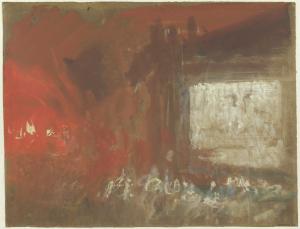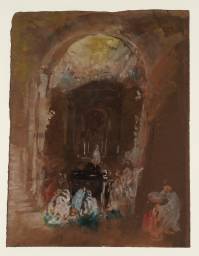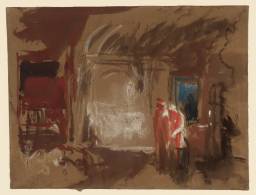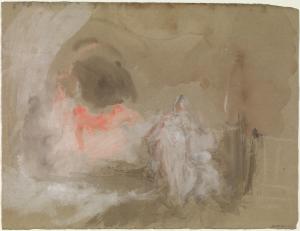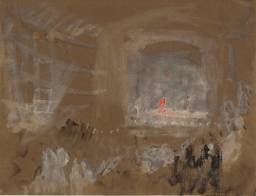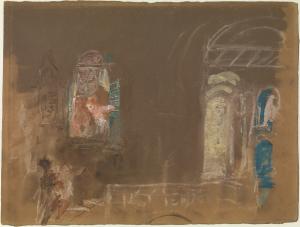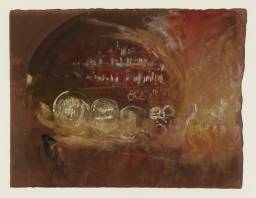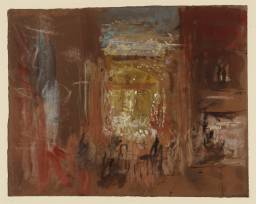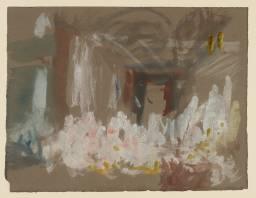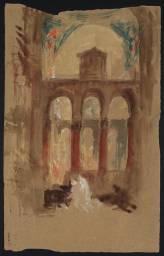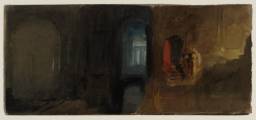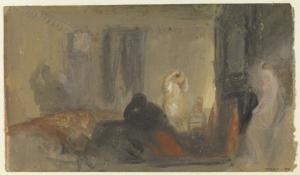Turner Bequest CCCXVIII 4, 7–9, 12, 17, 18, 20–22, 25, CCCXIX 4, CCCLXIV 243, 392
This section comprises separate sheets of studies in colour on brown papers, showing shadowy interiors or architecturally enclosed outdoor spaces with figures, sometimes clearly defined, sometimes in silhouette or brushed in provisionally as ghostly white forms against the warm backgrounds. D32226, D32227, D32241, D32252 (CCCXVIII 7, 8, 22, CCCXIX 4) show identifiable aspects of the crepuscular Basilica of San Marco (St Mark’s); others, whether real, transformed through memory or from imagination, may include a glass workshop (D32223; CCCXVIII 4), a theatre (D32237; CCCXVIIII 18), and a wine shop (D32240; CCCXVIII 21); there are also more intimate domestic settings.
Were it not for their technical similarity, painted in broad chiaroscuro on the Italian papers also used for contemporary topographical subjects (as discussed in their individual technical notes; see too the Introduction to the tour), some might hardly be linked to Venice at all. D36259 (CCCLXIV 392), with figures in states of undress in a darkened interior, has previously been associated with the 1827 gouache studies on blue paper of Petworth House in Sussex (Tate; Turner Bequest CCXLIV) including bedroom scenes,1 while the barely formed but evidently naked sprawling figure in D32236 (CCCXVIII 17) recalls dimly defined bedroom scenes in the small sketchbooks of the ‘Erotica and Improvisations c.1834–6’ section of this catalogue.
The latter study is so ambiguous that it has been discussed variously as an episode from Shakespeare’s Venetian-themed play Othello, a ‘murder scene’ or a personal recollection or fantasy. Likewise, rather than echoing the perversely Venetian backdrop of the 1836 painting, Juliet and her Nurse (private collection; engraved in 1842 as ‘St Mark’s Place, Venice’: Tate impression T05188),2 D32239 (CCCXVIII 20) may show a more profane interaction than Romeo’s wooing beneath the (originally Veronese) balcony.
Stylistically, Andrew Wilton has observed that these sheets ‘share a fascination with Rembrandtian lighting effects’ which Turner had explored in some of his paintings earlier in the previous decade.3 Looking ahead to the artist’s own influence on others, in discussing the 1895–6 oil Interior of St Mark’s, Venice by Walter Richard Sickert (1860–1942; Tate N05314) Robert Upstone has evoked these Venetian interiors, ‘as they too are painted in loose, fluid brushstrokes, and have the same sort of low-key palette accented with highlights’.4 Although he gives two of Turner’s St Mark’s interiors (Tate D32226 and D32241; Turner Bequest CCCXVIII 7, 22) as examples,5 neither they nor any of the comparable 1840 works on grey and brown papers (Turner Bequest CCCXVII–CCCXIX) are recorded as among those numbered and displayed in National Gallery selections during the nineteenth century. A few sheets from these sections were included in the touring regional Loan Collections which were shown occasionally in London too,6 but any technical resemblance is likely fortuitous. Nevertheless Sickert’s published remarks on Turner were generally brief but often highly complimentary.7
Perhaps the best-known and most straightforward of Turner’s 1840 Venice interiors, a brightly tinted watercolour on buff paper showing his sunlit bedroom at the Hotel Europa (Palazzo Giustinian) and the prospect high over the city outside (Tate D32219; Turner Bequest CCCXVII 32), is included in the parallel subsection of Europa-related views.
See Martin Butlin in Butlin, Mollie Luther and Ian Warrell, Turner at Petworth: Painter and Patron, London 1989, pp.93, 94 note 7.
Martin Butlin and Evelyn Joll, The Paintings of J.M.W. Turner, revised ed., New Haven and London 1984, pp.215–17 no.365, pl.369 (colour).
Andrew Wilton, Turner in his Time, London 1987, p.186; see also David Blayney Brown, Original Eyes: Progressive Vision in British Watercolour 1750–1850, exhibition catalogue, Tate Gallery Liverpool 1991, p.46.
Robert Upstone, ‘Interior of St Mark’s, Venice 1895–6 by Walter Richard Sickert’, catalogue entry, May 2009, in Helena Bonett, Ysanne Holt and Jennifer Mundy eds., The Camden Town Group in Context, Tate Research Publication, May 2012, accessed 3 November 2017, https://www.tate.org.uk/art/research-publications/camden-town-group/walter-richard-sickert-interior-of-st-marks-venice-r1138998 ; see also Robert Upstone, Sickert in Venice, exhibition catalogue, Dulwich Picture Gallery, London 2009, p.16, and Nicola Moorby in David Blayney Brown, Amy Concannon and Sam Smiles (eds.), Late Turner: Painting Set Free, exhibition catalogue, Tate Britain, London 2014, pp.109, 111.
For dates and venues see Ian Warrell, ‘R.N. Wornum and the First Three Loan Collections: A History of the Early Display of the Turner Bequest outside London’, Turner Studies, vol.11, no.1, Summer 1991, pp.33, 39, 46.
How to cite
Matthew Imms, ‘Venice: Interiors and Figure Scenes 1840’, subset, September 2018, in David Blayney Brown (ed.), J.M.W. Turner: Sketchbooks, Drawings and Watercolours, Tate Research Publication, December 2019, https://www

